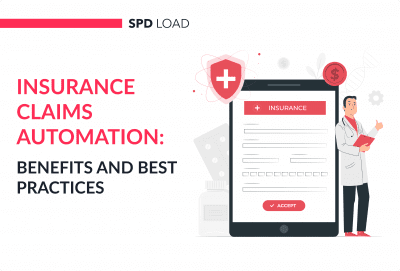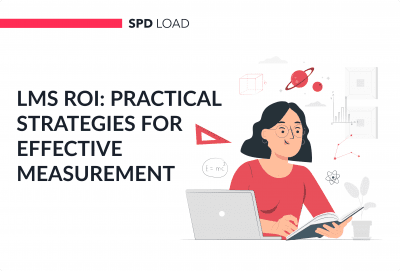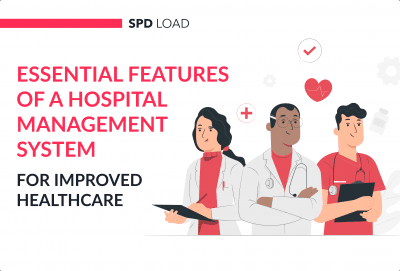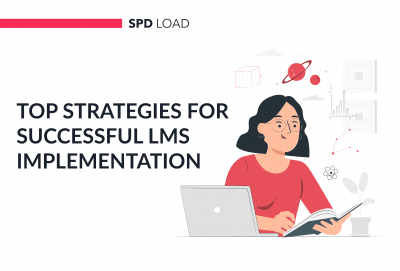eCommerce App Development: A Step-by-Step Guide
- Updated: Nov 12, 2024
- 16 min
Consumer perspectives on shopping have completely transformed over the last decade. Customers today prefer buying online rather than in physical stores.
If you’re considering moving your brick-and-mortar business into the digital marketplace, the time is now.
An estimated 2 billion people will use e-commerce to purchase goods and services in 2025 alone, so the opportunity is immense. Don’t wait — act today!
In this blog post, we’ll answer the million-dollar question: how do you develop an e-commerce app?
Let’s dive in!
Looking to launch an eCommerce business? Check out these eCommerce startup ideas for fresh inspiration.
Transform your ideas into reality with our expert developers and designers — contact us to get started today!
Why Launch an E-Commerce App
Impact of the Pandemic
Many physical outlets had to shut down in the wake of communal spread. Yet, some digital stores made merry, but not all and not all over the world.
With the global outburst of COVID-19, it has become even more crucial to build e-commerce mobile software.
Market Growth
According to statistics, the e-commerce market witnessed an acceleration in a few parts of the world. The parts include Central and Eastern Europe, the Middle East, Africa, and Latin America.
With a forecast made for e-retail accounting growth of more than 14.1% of all retail sales, there is no good time than now for e-commerce mobile app development.
Farfetch is one such example, besides a few more.
The luxury online portal claims they did not feel the heat of the global crisis. Farfetch grew as anticipated, rather more rapidly.
So much so, it is now looking for an alliance with Alibaba and is set to make an entry into China, the world’s fastest-growing e-commerce market.
Amazon too was a big player during the crisis. It ensured that the customers received their orders within the confines of their homes.
People now look at e-commerce apps for almost everything.
Therefore, build a mobile e-commerce application and start selling online. 
How to Build an E-Commerce App: Business
Before you develop a mobile e-commerce app, understand how valuable it will be for your business and for the users.
This assurance will inspire you to build an app with the utmost detailing needed at the moment.
Why do we say so? Read on to know!
Define the Unique Value: Target Audience
It is expected that mobile e-commerce sales would account for 72.9% of the total e-commerce sales in 2021.
With more smartphone users, an app can make a dream run for any smart businessman.
The smartphone users in the world will cross the 3.8 billion mark in 2025, as per an estimate.
Hence, you have a huge scope of the app’s success. This also demands attention to the app that you need to develop.
For instance, whether you need to develop clothes shopping app, gadgets, groceries, or any other.
Moreover, make sure you only need to fulfill the basic requirements needed.
E-commerce mobile app development that comprises all the killer features will appeal well to your target audience. 
Killer Features
Understand it like this: the app design process makes all the difference. It is the graphics that summon the attention of the customers first hand.
Adding killer features makes a similar impact on the visitor or the prospect for turning him or her into a buyer.
Some of the startling features worth considering in e-commerce application development include:
- Easy sign-in,
- Superfast checkout,
- Advanced searchability,
- Customer wishlist,
- Effortless login,
- Customer service support,
- Personalized content,
- Product reviews, and so forth.
With this information in your hands, it is now time to validate the idea of your e-commerce mobile app development idea. 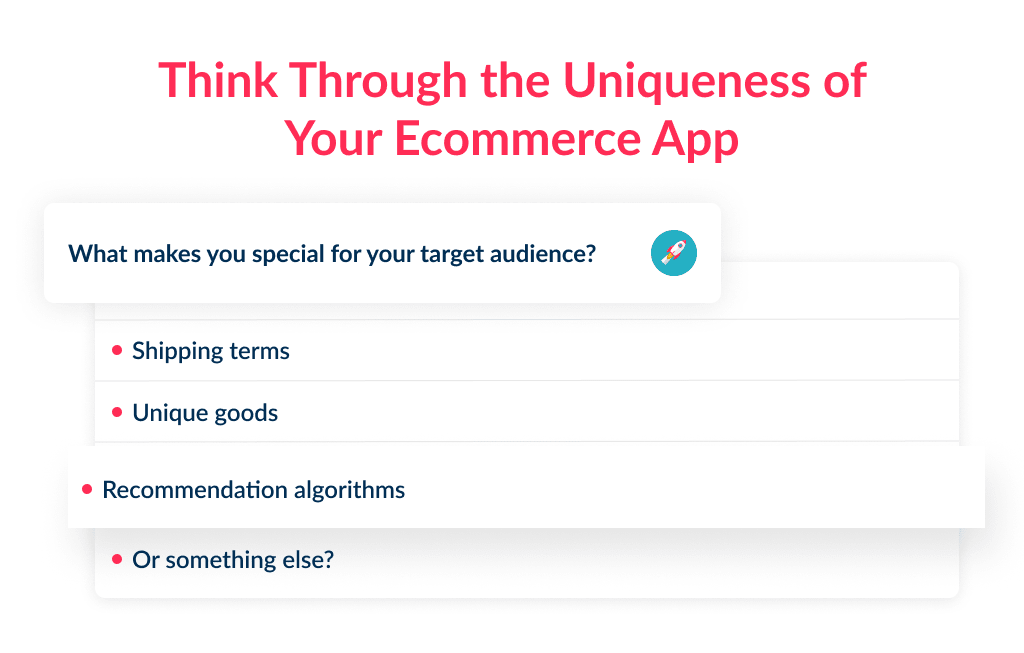
Validate the Hypothesis: Free Options
An ad campaign on Facebook is an excellent move to get to your target audience. The platform offers you location and demography customization.
You may even consider splitting campaigns to know your customers’ preferences from digital e-commerce stores.
An online social platform, such as Linkedin, helps you conduct virtual interviews.
You can ask your prospects about the problem, concept quality, and all the weak and strong points to create an impeccable mobile app.
There is no other forum as credible as Reddit is. Look for relevant topics, resources, and platforms to reach your target audience for your e-commerce business.
Use TyForm for developing your app. It is a great option.
- Create Wireframes
After you have basic information about user preferences, it is time to create a basic wireframe in the process of how to develop an e-commerce app.
A wireframe will help you visualize a basic version of the app in your mind.
Thus, making validation easy. It will also help you get a rough idea of e-commerce app development costs.
Expertise gap? Let's bridge it together. Share your needs and elevate your team with our experts.
Paid Options
- Create a Landing Page and drive traffic to
If you can pump in some dollars, then go ahead and create a landing page. This is a costly but effective option that is useful in receiving value propositions.
If you are lucky, you may even land some of your first customers from this investment.
Moreover, having a landing page will help you garner user trust as users believe in what they see. 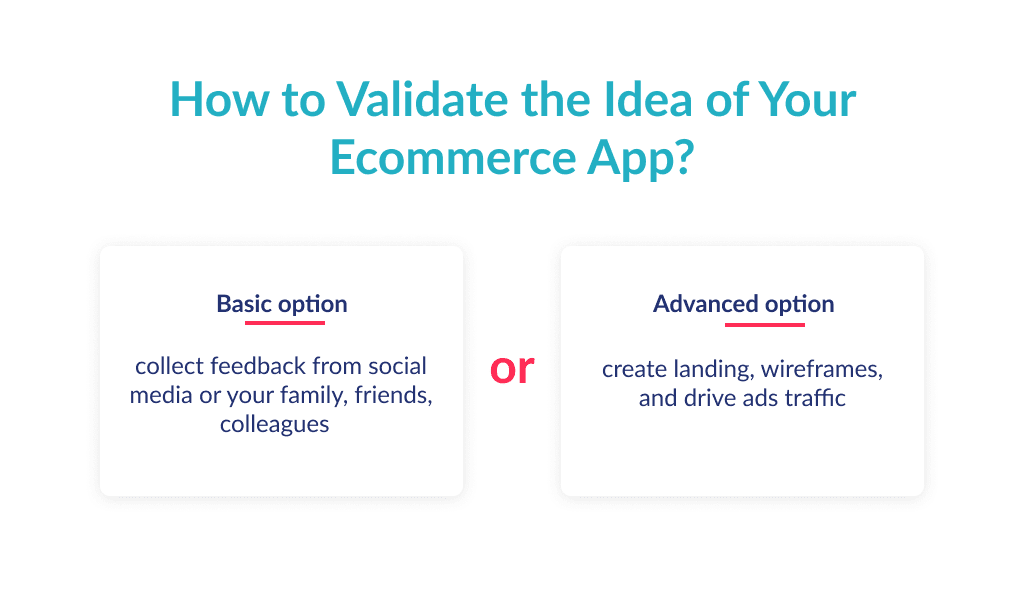
Discovery Phase
Once you have validated your business, it is now time to plan. It becomes even more critical for controlling e-commerce app development costs.
Your project discovery phase involves more than one aspect.
What Is It in E-commerce App Development?
Here is what the discovery phase of how to develop an e-commerce app process includes:
- Market analysis
- Competitor analysis
- Identification of the target audience
- Identifying business goals,
- Cost analysis
You must be wondering why you need a discovery phase, after all.
The Discovery phase is the foundational step in e-commerce mobile app development.
As per a survey by MarketingSignals, 90% of the e-commerce startups fail in the first year.
The reasons vary from
- inability to compete,
- lack of online visibility,
- no market for their services or products,
- over exceeding the budget, poor marketing,
- inefficient team,
- and bad timing for the launch of your digital store.
To overcome the above, the discovery phase allows you to
- look for the opportunities,
- prepare the plan, document it in detail,
- validate your business idea
- and look for the target audience to make your business a success.

How Does the Discovery Phase Help?
Here is what the above-mentioned points about the discovery phase help in.
With proper market research, competitor analysis, cost analysis, and others, you can:
- Build Market-driven Product
With project discovery, you will discover the market before you take that leap of faith.
It serves two purposes, one, understand the scope of the business, and two, check any cost deficiency in making an e-commerce app.
- Document the project effectively
You have been doing so many things to shape your mobile e-commerce app. It is recommended to document it all.
All the details documented prove beneficial at each step of the app development. It saves both time and money.
- Prototype product
What purpose do prototypes serve? These help build the idea you have for your e-commerce application development and see if it is workable.
This helps your team understand the project and establish the cost of the project. Besides, they learn what all can be done to improve the user experience.
- Test Qualitative Service
As you are building an e-commerce app for the customers, so, their views matter. Neglecting their needs and aspirations can waste your time and money invested.
The discovery phase helps you save that time and money by letting you test the prototype or MVP.
Ready to test your startup idea? Learn everything about how to launch an MVP successfully. 
How Does an Owner Benefit?
From the discovery phase of how to develop an e-commerce app, the founder can get insight into several things:
- Manage Budget
One of the most significant benefits is a slash in e-commerce app development costs. In the discovery phase, you can document all the requirements in detail.
With this detailing, you can set time and overall cost and budget for the final product.
- Project Validation
Irrespective of your e-commerce business plan, the discovery phase helps you understand whether it is a good idea to move ahead.
Not only this, you will know whether you have the target audience for the same or not.
- Understand Risks
Every new venture poses some risks. Without discovering them, you may land yourself in deep waters. This may lead to missed deadlines and expenditures.
Discovering them beforehand is advantageous in preparing for the risks in e-commerce application development.
- Build a Team
A phase such as this will make you understand the kind of team you need while learning ‘how to develop an e-commerce app.’
This means you can hire the right, qualified people and for the best team coordination process. 
How to Build an E-Commerce App: Technical
In the technical part of e-commerce application development, first come the features of the app.
MVP Core Features
For the first-timers, you must have an MVP for your idea, before jumping to the development of a scaled product. You may ask, what is an MVP in e-commerce mobile app development.
MVP allows testing the product idea while it is still in the developmental cycle.
It can be defined as an early version of the final product. With an MVP, you design a vision and strategy in line with the market requirements.
Once the MVP is launched and users provide their feedback, you can use these 6 best practices to scale your e-commerce business.
An MVP also assists the design, management, and development team to improve the mobile e-commerce app.
Learn how to transform your MVP into a fully-fledged product with our tips on from MVP to full-scale product.
| Features | Description and Advantages |
| Signup/Sign in | Make signing up or signing in an easy process for your customers. Allow them to use their email address or use an external account such as Facebook to log in safely. Don’t ask for too much data. This scares the user, especially on digital stores. |
| Onboarding | This feature marks the beginning of a customers’ journey on your app. With this, you can present your product along with its advantages more effectively. Build your app relationship with the customer with onboarding. |
| Personal Profile | Customers prefer a personal profile for varied reasons during shopping on e-commerce apps. On their profile, they can maintain their orders, addresses, payment methods, and favorites. While shaping up your app, add this feature to personalize one’s profile. |
| Advanced Filters | A wide range of products calls for sorting and filtering to make it easy for the customers to choose and buy. This time saving goes a long way in building loyalty among the customers. Enhances your business’s user experience for repeat customers on the mobile app. |
| Search Bar | Prospects often land to buy something specific. A search bar provides them with easy access. No search bar makes the customers confused and may increase the bounce rate of your website. While making an app, make sure to place it at the top for easy navigation. |
| Product Page | An attractive product page can bring more customers than any other tactic. Make it rich with comprehensive information such as price, shipping information, sizes, colors, availability, etc. Not to forget, clear images, preferably in a gallery. Product pages can make or break your sales. Here’s how to design eCommerce product pages for success. |
| Shopping Cart | One of the top features that make or break a mobile application is a shopping cart. A customer can use it while selecting and even after. A must-have feature helps build a positive user experience and saves time. Make it easily accessible. |
| Payment Gateway | In-app payments are a great option appreciated highly by the customers. Offer them several payment gateways, including online transfers, mobile wallets, and credit/debit cards, etc. A permanent gateway helps in quick and safe payments. So, add it to your e-commerce application development process. Wondering how to accept card payments on your website? Check out our guide on how to accept card payment on-site for all the details. |
| Push Notifications | This feature is excellent for sales and promotions as it helps in informing customers with ease. It helps in improving user experiences and consequently increasing sales of a shopping app. While establishing your e-commerce software, use analytics to segment your audience. |
| Order and Delivery Process | Your customer needs it to make a purchase and track how and when the shipment would be delivered. Simultaneously, you can communicate the order and shipping information at any given point in time. The process helps to send delivery updates. Embed this before launching your digital store. |
| Analytics | Analytics help startups collect data of customers, products, and orders. Understanding customers is far easier when you can read their favorites. Include analytics in e-commerce application development to present your offers to the customers. |
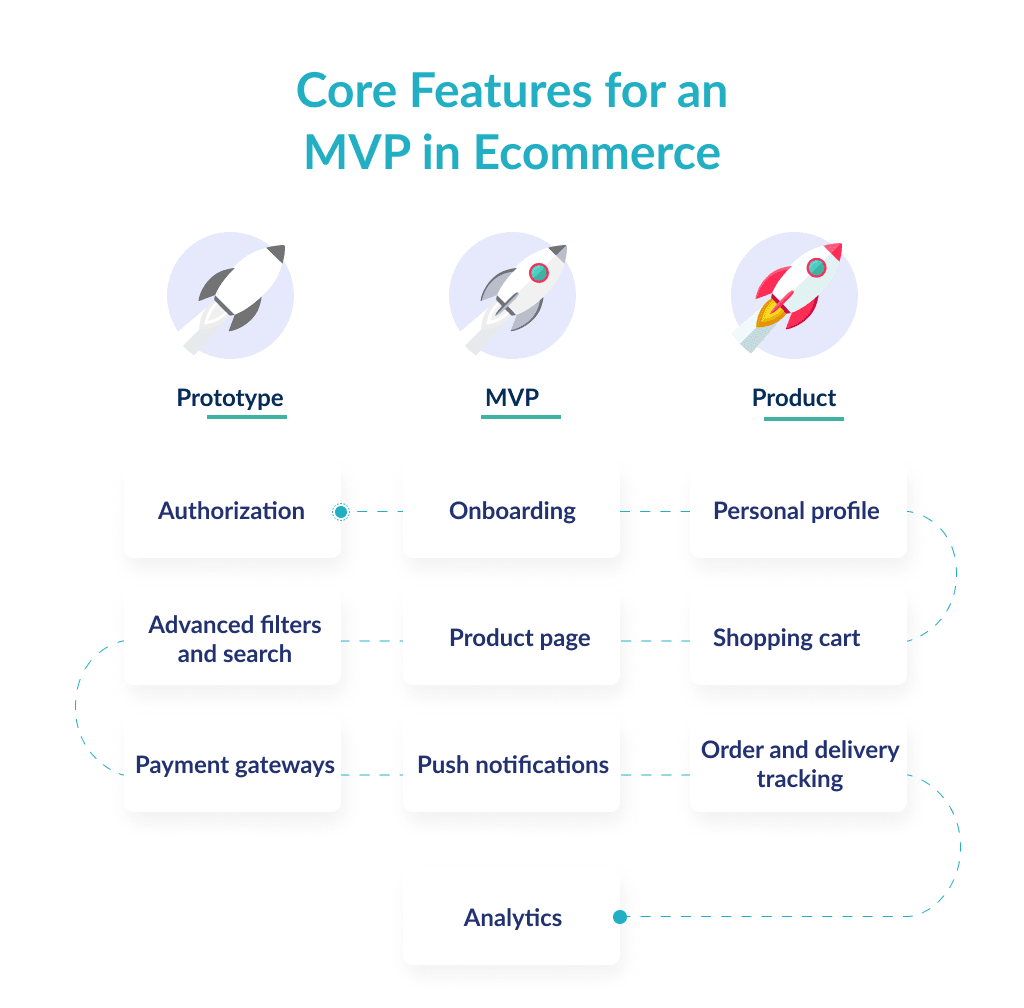
App Design
One of the prime factors determining the success or failure of a mobile e-commerce app is the design.
However, a well-made design is not achieved without the preparation needed.
Additionally, you must pay attention to some of the aspects associated with it, such as.
- Layout
- User interface
- Colors
- Button Placement
And more to enhance the visual appearance and functionality of a mobile app.
However, it is crucial for you as an owner to control the e-commerce mobile app cost initially allotted yet produce great functional software.
Without much ado, now let’s discuss the design of an e-commerce app. 
What Design Will Work for You?
Every user sees the app differently. So, how to develop an e-commerce app that hits the bullseye? You must remember this and work accordingly.
Invest ample time to ensure the quality of the end product.
There are two types of mobile apps that you can consider.
- Native mobile app
- Hybrid Mobile app
| Native Mobile app | Native apps are called native, as they are built for a specific operating system. It cannot be used on any other platform and is bound with some platform-specific guidelines and elements. For instance, you cannot use a native Android app on iOS. However, it has its own set of benefits, such as low e-commerce mobile app cost, excellent user experience, and high performance. Coding for native apps is in Java, Python, Kotlin, Swift, React, Objective-C, or C++ programming languages. To learn more about iOS development, take a look at these best iOS development tools. |
| Hybrid Mobile App | E-commerce mobile app development of a hybrid app implies you will have a mix of Android and iOS versions. They are easy to build, are less expensive than native apps, and can be developed faster than native apps. Above all, just a single app for all platforms. A hybrid app uses technologies such as CSS, HTML, Javascript, jQuery, Cordova/PhoneGap, Mobile Javascript, etc., for development. If you’re planning to build an app, these detailed guides on Android app development costs and iOS app development costs will help you navigate the financial aspects. |
UI/UX Tips
Apart from the above, you must know a few tips and tricks in e-commerce mobile app development. These can influence a user’s behavior.
And these users comprise more than 3.5 billion smartphone holders.
Out of the above, as many as 80% of users have made online purchases using their mobile devices.
So, to entice them, you would need a good roadmap and a few tips as well:
- Make key elements within easy reach of the user. This includes the area in the center or the left zone, or the lower-left corner. These are thumb-friendly zones for both left and right-handed people.
- Keep the checkout process short and simple. A long checkout process can bore your customer. He may even turn away. So, ask for the most important information needed.
- Minimalist design. A simple user-interface helps the customers locate their desired products. Adding complexities will only make it difficult for them. To make it clearer, use simple color schemes, add spacing, and preferable, only one typeface.
- Be consistent. Consistency helps maintain the functional, visual, and external appearance of an e-commerce app. Consistency also helps in maintaining the structure of the application.
- Smooth Navigation. Easy to navigate design increases customer satisfaction. For instance, site navigation should appear constant and unchanged on every page. It serves the purpose of a map.
- Security. Customers look for 100% security while making transactions on any e-commerce app. You must add it while making an app to instill confidence. Add a trustworthy contact us page, financial and personal data encryption guarantee.
Crafting Custom Mobile Apps That Delight Users!
A few more features are pertinent to a shopping app. These are important for developing an e-commerce mobile application design. 
Additional Product Features
Here are some additional features that you can add to your app for added functionality.
| Feature | Description |
| Social sign in | There is no better way to verify the identity of a user than a social sign in. A user can authenticate a mobile application with his social network credentials. These can be Facebook, Twitter, Linked In, Google. It increases conversions while reducing failure in login attempts. |
| Chat with Sellers | The users appreciate a customer-centric approach, such as chat over email. Chats offer faster solutions. It also enhances your business aspirations with enhanced visibility and brand promotion. Besides, you get valuable feedback to store in your data for future reference. Effective strategies for building a brand from scratch can transform your vision into reality. |
| Tracking System | A well-built tracking system of an e-commerce app can serve many usages. The data tells you about the best selling products, the number of products per transaction, and revenue received per transaction. You can also learn about the time taken by a customer to take the final decision. This will help you understand fluctuation in the sales cycle if it occurs in the future. |
| Voice search | Voice search enables faster search and ordering. This hands-free shopping experience is gaining popularity across businesses. For instance, people can voice search for any product with Alexa. This market is expected to reach $40 billion in the US and UK alone by 2022. At present, groceries top the list of voice searches, and others will join the bandwagon soon. |
Now is the time to build a team for shaping up your digital store. 
Required Team
The process of how to develop an e-commerce app requires some reliable and talented people. E-commerce application development requires a comprehensive team like:
- Project Manager
- Business Analyst
- Designers
- Backend developer
- Mobile developer
- Tester
- DevOps (here are emerging DevOps trends and how they can benefit your development)
But how to choose the right partner?
With an ocean of talent, it becomes challenging to choose the correct set of professionals for your e-commerce application development.
So, consider some crucial factors before taking anyone on board. 
The Right Places to Find Partners
There are many places you can find reliable partners for, including
You should start with Google. It is the easiest and most accessible place to look for partners to develop your e-commerce application.
It may or may not fetch you what you are looking for, but you will get to explore a multitude of options.
For instance, you may come across a few blogs to find team members to shape up your app.
- Company Forum
You may come across a few blogs on a company forum where you will find what you are looking for.
You can look for agencies and firms to hire partners on various company forums. You get all the details required before hiring here.
This includes employees, rate/hour, reviews, and their country. Some online websites you can explore for the same are Birdeye, Clutch, and Good Firms.
Company forums list only legitimate companies.
So, The information provided by these websites is 100% authentic. There is hardly anyone you won’t find in your endeavor to create a mobile app.
- Reference/ Recommendation
Another method to hire the best partner is through a reference. You can ask for it within your network. But, while taking him as your partner, do ensure he is fit for the job.
An e-commerce mobile app development firm operating in the niche is the best option for you is recommended.
And, look for the feedback of your recommendation.
Picking the right partner is crucial — here’s how to choose an app development company that fits your needs. 
Tech Stack
There are a few must-have underlying software and services for seamless e-commerce mobile app development.
Find them below.
| Tool | Application |
| G Suite | G Suite offers enterprise-based products such as Gmail, Docs, Drive, and Sheets. It is now called Google workspace. You will need these to make a mobile e-commerce application. |
| Figma | Figma makes collaboration among organizations easier. You can share prototypes and designs of the software under development. You can use digital projects designed in the cloud-based Figma designs anywhere. With templates, graphics, themes, photos, and graphics, it is second to none. |
| AWS | Amazon web services or AWS offers services to build scalable shopping applications. The hosting service offers services such as storage, migration, compute, database. Management tools, messaging, and network and content delivery. Discover the strengths and weaknesses of Digital Ocean, AWS, and Google Cloud to find your ideal match. |
| Node.JS | An open-source framework helps in realizing your web app ideas. It is secure and maintainable. Node.JS framework is known for high performance, reliability, efficiency, expandability, and many authentication options for shaping an e-commerce application. |
| React JS | If you are looking to build a single page application, React Js is the best option. It is an open-source framework used to build user interfaces. The front end web development tool requires minimal knowledge of HTML and Javascript. It allows the development of reusable UI components for a mobile app. |
| 3rd party integration | Third-Party integration allows developers to use external data. Different APIs (Application Program Interfaces) are useful in the development process of mobile software. This helps in finding a solution in a short span with the external components. Certain impeccable features make sure you add the best possible features to your app. |
| Testing | Testing helps you validate the consistency, functionality, and usability of the software on handheld devices. It helps you find errors and defects in an e-commerce mobile application. |
E-Commerce App Development Cost
The e-commerce app development cost varies based on the location and the type of service you are opting for.
Broadly, there are three ways by which you can get the e-commerce app developed:
- The US’s local development agency
A local agency in the US charges the highest for e-commerce app development, at $150 per hour. However, the quality of the work is top-notch.
- Freelancers
They are a cost-effective option for you. However, work quality is not always right. Make sure you verify the person or freelancing agency for their work before assigning them your priced work. The charges of freelancers begin from $20 an hour.
- Outsource agency in Ukraine
The best option of all is to look for an outsourcing agency in Ukraine. With this option, you will get the best app at a reasonable price. The hourly rate of a local agency in Ukraine is $40. Hence, a cost-effective method of app development.
The average cost of an MVP for an e-commerce app may vary between $30,000 to over $250,000.
Without reliability, creating an app would be like moving without believing in the strength of your legs.
And this comes from the abilities of the partner, which you must ascertain before moving ahead.
For trusted IT partners, explore the best IT outsourcing companies listed here. 
Ready to Build Your E-Commerce App?
Following this comprehensive guide, you now have all the insider knowledge on how to build a successful, scalable e-commerce app.
Now is the time to adapt your business to the digital shopping revolution. Meet changing customer demands and claim your stake in the booming e-commerce market.
Our expert team has launched dozens of mobile apps and web platforms across e-commerce, fintech, healthcare, and other industries. We leverage the latest technologies and data-driven insights to create innovative digital solutions tailored for each client.
Want to build a robust, feature-packed e-commerce app that drives real ROI?
Let’s talk to define your e-commerce vision, discuss capabilities and budgets, and craft a custom digital strategy for your brand.
Outsourcing can streamline your app development. Here’s a complete guide on finding the right mobile app developers.





